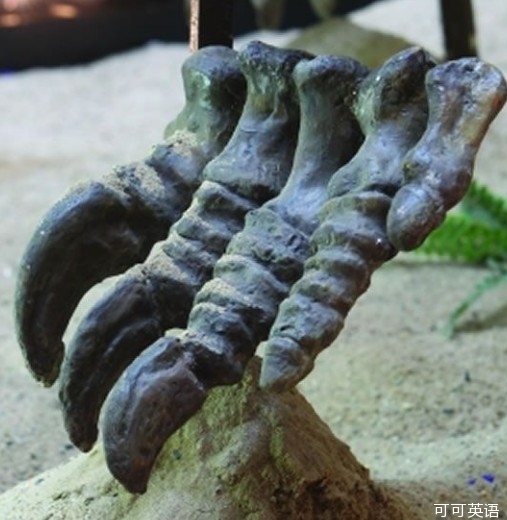(单词翻译:单击)

Science and Technology Palaeontology Splay-footed, not flat-footed
科技 古生物学 不是扁平足而是八字足
A new fossil shows that evolution does not always mean change
新发现的化石显示,进化并不总意味着变化
WHEN a coelacanth, a type of lobe-finned fish once considered the missing link between fish and amphibians, was found off the coast of South Africa in 1938, it came as a shock to palaeontologists. Until then, the most recent traces of such a creature had been in rocks dating from the last days of the dinosaurs, 65m years ago. It was, in its way, as surprising as if a live Tyrannosaurus had been found hiding in an obscure part of Montana. Now the same experience is hitting palaeontologists again—but this time in reverse. Instead of finding a "living fossil" identical to an ancient beast, they have found a real fossil identical to a modern one.
1938年当一种空棘鱼目鱼类---曾被认为是一种消失的连接鱼类和两栖动物的物种在南非海岸被发现时,古生物学家们为之一惊。至到当时,这种生物最新的踪迹只出现在可以追溯到距今六千五百万年前恐龙时代末期的化石中。其惊人程度就如同在蒙大拿的某个阴暗地方发现了一只躲藏于其中的活体霸王龙。如今,同样的事件再次让古生物学家们感到震惊---但是这次恰恰相反,他们不是发现了一个与远古生物雷同的"活化石",而是发现了一个与现代生物一致的真化石。
The fossil in question, a 100m-year-old specimen from north-east Brazil, belongs to the genus Schizodactylus. These are large, carnivorous, cricket-like insects whose feet splay out wildly in different directions. Modern Schizodactylus use their feet like snowshoes, to help them remain stable as they travel over sandy terrain in search of prey.
这里所讨论的化石中的生物是一个来自巴西东北部距今一亿年前的物种,属于Schizodactylus昆虫科。它们是一些大型,蟋蟀状食肉昆虫,其足向不同方向伸展。当现代Schizodactylus科昆虫在沙地中搜寻猎物时,其足有如雪鞋可以帮助它们保持稳定。
If the new fossil—whose discovery has just been published in ZooKeys by Sam Heads of the Illinois Natural History Survey and Léa Leuzinger of the University of Fribourg, in Switzerland—were merely similar to modern splay-footed insects, the find would not be particularly surprising: it simply demonstrates a phenomenon called evolutionary stasis, in which a specific type of body form hangs around for a long time. What is surprising is just how static Schizodactylus has been.
如果该新发现的化石---它的发掘已经被来自伊利诺亚州自然历史调查所的山姆.海兹以及来自瑞士夫里堡大学的雷.卢辛格发表在了《Zookeys》杂志上---仅仅是与现代八字足昆虫相似,那么这一发现也没有什么大惊小怪的:因为这只显示了一种叫做"进化停止"的现象,其间某一特定体态在相当长一段时间内保持不变。然而让人感到惊奇的是Schizodactylus科昆虫的进化尽然是如此得缓慢。
Evolutionary stasis is fairly common at the higher levels of the Linnaean system of biological classification (class, order and family). Natural selection hits on a good design. That design is then adopted in slightly different forms by species after species. The shelled bodies of turtles, for example, evolved between 250m and 200m years ago, while the body plans of scorpions have been around for more than 400m years. That does not mean, however, that a zoologist would mistake a 200m-year-old turtle or a 400m-year-old scorpion for any species now alive.
进化停止在生物分类法(如纲,目和科的分类)的林奈分类体系中的高级别生物里比较常见。当自然选择挑中了一个理想的设计后,一个接一个的物种便以略微不同的形式采纳这种设计。举个例子,海龟的甲状躯壳约在2亿5千万年前至2亿年前就已经进化完成,相比之下蝎子的身体构制更是在4亿多年内都未有大的变化。然而,这并不意味着一位动物学家可以将一只2亿年前的海龟或是一只4亿年前的蝎子与现在对应的活体物种混为一谈。
What is remarkable about the new find is that it is so similar to modern animals that it can be assigned to an existing genus—the lowest level of Linnaean classification above a species—rather than just to some higher taxonomic group. That is rare indeed. Even the modern coelacanth, on closer examination, had to be put in a different genus from any known fossil.
而这一新发现令人关注的地方在于化石中的物种与现代对应物种是如此得相似以至于它可以被当作是现代物种的某一现存种类---种类是林奈物种分类法中最低的一级,而不是更高级别的种群。这的确很罕见。经过进一步检验,(我们发现)就算是(当时在南非海岸发现的)现代空棘鱼的种类也有别于任何已知化石中的空棘鱼的种类。
Clearly the body plan of Schizodactylus is not merely good, but optimal, at least for the environment the animal lives in. Alas for Schizodactylus, the sandy deserts it prefers have retreated from north-eastern Brazil and its optimality there has vanished. But its discovery shows better what this part of the world was like 100m years ago—and also illustrates an important point about evolution that is often forgotten in biologists' understandable focus on the development of novelty. The first rule of natural selection is: "If it ain't broke, don't fix it."
显然,Schizodactylus科昆虫拥有的的身体构制不仅令人满意,而且是最佳的,至少是为了其所生存的环境而生。而让Schizodactylus科昆虫感到悲哀的是其所青睐的沙漠在巴西已经消退而它们的最佳身体构制也随之消失。但是该化石的发现更好地展示了世界的这一地区在1亿年前是个什么摸样---同时也阐明了有关进化的一点重要内容,一个经常在生物学家对于发展的推陈出新所持有的一种可理解的关注中而被遗忘的一点内容。自然选择的第一条规则就是:"未损勿修。"


